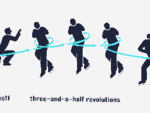Women, more than men, are more likely to suffer knee pain; perhaps because of the way women hold their hips and trunk during athletics, causing higher incidence of knee pain and ACL injuries. The knee is the most unstable joint, and women often do suffer various kinds of knee pain. Another theory for the higher rate of knee pain in women is that men athletes more often assume a squat-like stance during sports, which helps protect the knee.
This squat-like stance makes the ACL (anterior cruciate ligament) of the knee less prone to injury, but it’s not clear why men, more than women, assume this protective positioning. This squat-like stance doesn’t have to be 90 degrees, either. Women can protect the knee and ACL by assuming a partial squat while playing sports and also inline skating.
Sedentary women also must take measures against knee pain and ACL injuries.
All women should have a habit of lowering their center of gravity while doing things like going down staircases, playing tag with the kids and hiking downhill. The knee and ACL are protected with this lowered center of gravity; protected not only from annoying knee pain or excessive wear and tear, but from giving out. Have you ever observed a skier standing straight while zooming down a hill? How about a ski jumper making a landing with straight legs?
Women suffer a higher rate of ACL injuries for two reasons, cited by the American Academy of Orthopaedic Surgeons:
1. Biomechanical aspects. Women usually depend more on their quadriceps muscles while performing athletics. But more involvement of the hamstring muscles can bring down ACL injury risk and reduce knee pain. Women, more so than men, land with flat feet rather than on the balls of their feet.
2. Environmental aspects. Risk of knee pain or ACL injuries go up with high surface traction shoes.
Additionally, women athletes tend to bend their knees LESS frequently than men do, plus turn their knees in more, while performing side to side jumping, says a University of Pittsburgh study. Sudden changes in direction are also common causes for ACL injuries or knee pain; a sudden change while the foot is firmly planted on the ground or gym floor during basketball, volleyball, soccer or softball, or even during a fitness class.
ACL injuries often require surgery, followed by up to nine months of rehab, and then a nice permanent scar to show for it. Women can to learn more effective techniques they can apply to landing from jumps, body positioning during physical action, and actual jumping. And it’s so important to adopt exercise routines that hit the upper leg muscles good and hard so that they will be strong and durable.
Knee pain can also result from a wearing down of the underside of the kneecap; cartilage tissue that provides shock absorption to the knee joint. The condition is called chondromalacia, and classic symptoms are knee pain while going up stairs, or going down stairs, while jogging or right after jogging, a grinding sensation in the knee when the knee bends, and pain upon attempting to lock the leg in a very straight position.
Additional risk factors for knee problems are weak leg muscles, stiff leg muscles, misaligned knees, flat feet, leg-length disparity, and obesity or even moderate overweight.



